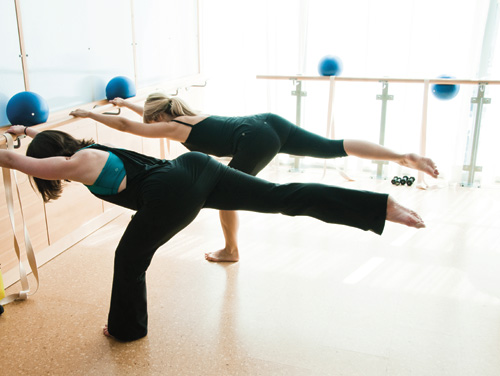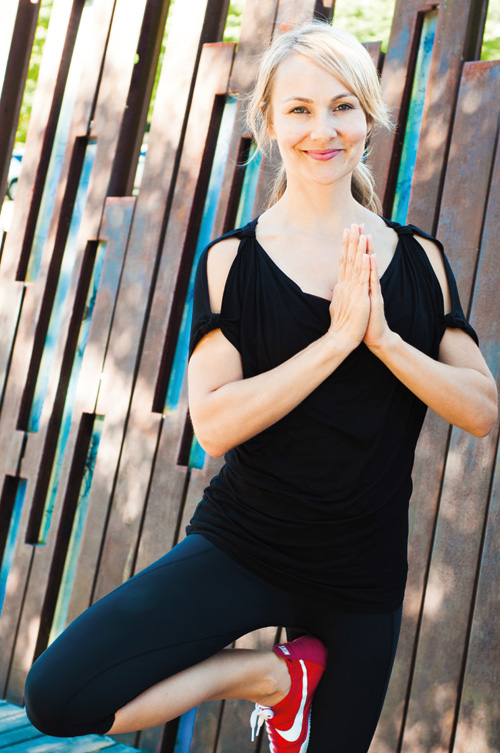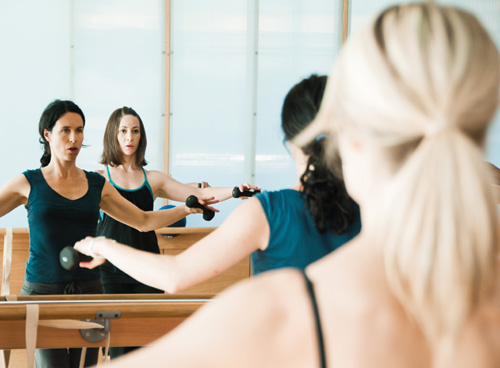 For decades, people have been sweating and stretching as an instructor leads the way (think Jazzercise, step aerobics or Jane Fonda). As long as misery loves company, it seemed group fitness classes would endure. But in the past few years — since the recession — group classes have become even more in vogue, a trend that’s buoyed a Portland-based startup.
For decades, people have been sweating and stretching as an instructor leads the way (think Jazzercise, step aerobics or Jane Fonda). As long as misery loves company, it seemed group fitness classes would endure. But in the past few years — since the recession — group classes have become even more in vogue, a trend that’s buoyed a Portland-based startup.
By Lucy Burningham
 |
Sadie Lincoln is the founder of Barre3, a fitness studio built around ballet barre exercise. The company has sold 22 franchises since it opened its first location in Southeast Portland in 2008. // Photos by Teresa Meier |
 |
 |
For decades, people have been sweating and stretching as an instructor leads the way (think Jazzercise, step aerobics or Jane Fonda). As long as misery loves company, it seemed group fitness classes would endure. But in the past few years — since the recession — group classes have become even more in vogue, a trend that’s buoyed a Portland-based startup.
Barre3, a fitness studio that offers hour-long classes structured around the same kind of “barre” ballet dancers use, opened its first location in Southeast Portland in 2008. Since then the company has sold 22 franchises, four of which are in the Philippines. A franchise costs $30,000, and the average studio employs 20 part-timers, and one to two full-time workers, including the owner.
Founder and instructor Sadie Lincoln, who launched the company with her husband, Chris Lincoln, says she didn’t anticipate such rapid growth, fueled in part by glowing media coverage in high-circulation publications including Marie Claire, Shape and US Weekly. (US Weekly revealed that Madonna was using the Barre3 method to stay in shape.) Not only did the coverage attract new franchisees, but it also propelled sales of Lincoln’s DVD based on the studio’s workout techniques — an extra she originally created for clients who weren’t able to make it to the studio.
Lincoln, a native of Eugene, says she wrote the business plan for Barre3 based on a shift in consumer preferences she observed during the 10 years she was employed at 24 Hour Fitness. “Gyms became ginormous and less intimate, which created a cultural change,” says Lincoln. “Just like people wanted to buy local, they wanted to work out local.”
Beyond the drive to support the indie business owner, fitness-minded consumers longed to exercise in a small setting, she says, which fosters a sense of community. “Especially since the recession, people want the connection group classes provide,” Lincoln says.
The International Health, Racquet and Sportsclub Association, an international fitness industry trade group, supports her theory. Based on polling of its 9,000 members, the number of socially based exercise classes, both in and outside gyms, has increased since 2008, especially when it comes to cardio-kickboxing, yoga, high-impact aerobics, dance-style classes and strength-training classes.
The group also reports an increase in “fusion” classes that combine exercise, yoga, Pilates and dance — precisely the Barre3 mash-up. While Lincoln admits barre work is trendy right now, she says the franchise’s unique sequencing of moves keeps clients faithful to the studios.
While she won’t reveal how many new franchises are in the works, Lincoln hopes the Barre3 buzz combined with the drive to work out in groups means even more people will join Madonna in this specific quest for a fit body.


